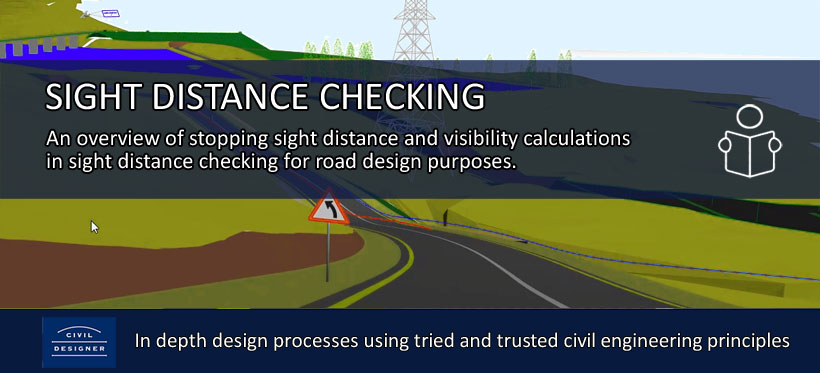Stopping sight distance is an important design consideration for safe roadway design, stipulated in engineering services guidelines and forming part of the controlling criteria for highway design in some countries(1). Design guidance for minimum stopping sight distance is a function of the design speed, driver perception-reaction times, and driver deceleration rates.
Where a specified section of road is being interrogated, the civil engineer can perform general visibility calculations in order to identify the locations which can be seen from sequential observer locations on the terrain. These results will indicate whether further design alterations are necessary in order to ensure compliance with the specified minimum sight distance.
Horizontal sightline offset
For minimum stopping sight distances at any point along a horizontal curve, minimum horizontal sightline offsets can be represented as indicated in the diagram below.

Horizontal sightline offsets and sight distances on sharp horizontal curves
Where modifications to the horizontal alignment of a road are necessary in order to improve safety there are several measures that can be implemented. These include increasing bend radius, providing transition bends (to facilitate the gradual transition of steering from straight sections of road to bends), removing compound bends or improving the super-elevation. Sight lines can also be cleared by removal of vegetation or by cutting the embankment on the inside of horizontal curves.
Vertical sightline profile
Changes in the vertical alignment can be developed with cut and fill grading if necessary. The radius of a crest can be increased for adequate sight distance by 'shaving' the top off of the crest and slopes can be graded with fill material.
Where sight distance cannot be significantly improved with design modifications, speed management or restrictions to vehicle movements such as right turns and overtaking may be considered along with appropriate advance warning signs.
Sight Distance Checking Settings in CIVIL DESIGNER Software
CIVIL DESIGNER allows the engineer to calculate the line-of-sight between objects located at different points of a design model according to the project specific design requirements. The sight distance analysis results take into account the horizontal and vertical alignments as well as the road profile.

Project specific settings for Sight Distance Checking in CIVIL DESIGNER
Not only can the sight distance envelope be displayed in the vertical alignment editor, allowing the engineer to step through the road layout and determine sight distance failures, CIVIL DESIGNER can also generate a rendered 3D fly-through along the road at a specified height for design verification purposes.
The design verification takes into account the full 3D profile of the road within the road
reserve, and marks areas where there is insufficient visibility in the forward and return direction.
CIVIL DESIGNER always relying on tried and trusted civil engineering principles giving the engineer the confidence of design integrity.
View a video demonstration of the rendered fly-through for Sight Distance Checking design verification in CIVIL DESIGNER below.
Sight Distance Checking design verification
Sight Distance Checking for Road Design | Rod Harris, Civil Designer International
Download a printable pdf copy of this article here >>.
References:
1. U.S. Department of Transportation (2016)
Revisions to the Controlling Criteria for Design and Documentation for Design
Cited on http://www.fhwa.dot.gov/design/standards
2. Mertzanis F. and Hatz, V, (2011)
Modelling Sight Distance Calculation and Three-Dimensional Alignment
Cited on http://onlinepubs.trb.org
3. Wood J. (2013)
Stopping Sight Distance and Horizontal Sightline
Cited on http://docs.trb.org
|







